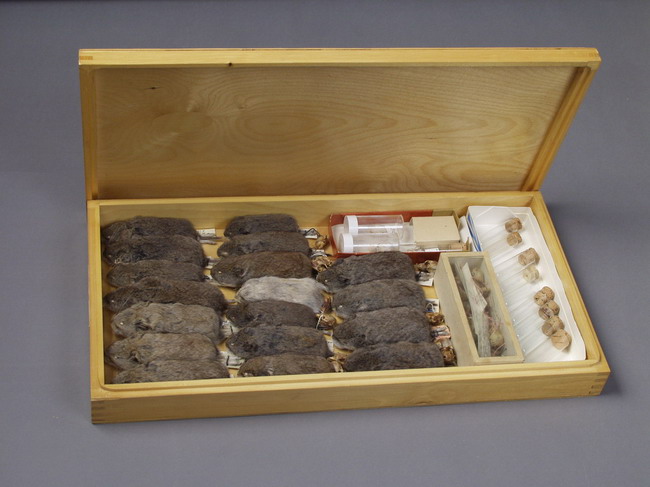Stuffed Mammal Skins collection
Curator: Natalia Krasnykh.
The collection
maintains 2 654 specimens, including the skins of small and medium-sized
mammals stuffed with cotton or other soft material (from the smallest species
to the groundhog and raccoon).
The first stuffed
skins of mammals were bought by Alexander Kohts, along with many other exhibits
from a number of well-known European companies in 1913. Most of these skins were
later used to make taxidermied animals between 1914 and 1953. Among the specimens
that remained in the original form, there are three notable skins of Australian
short-beaked echidna (Tachyglossus aculeatus) purchased from the London trading
company of Rosenberg, as well as individual specimens collected by well-known
professional collectors of that time - A. Everett, S. Underwood, M. Palmer.
In 1920, the Museum
bought a private zoological collection of V.N. Nikitin gathered in 1912 during
a trip to German East Africa, including two stuffed skins of the Gambian pouched rat (Cricetomus
gambianus). Between 1930 to 1950, the Museum collection was replenished by over
500 specimens collected in the Caucasus, Saratov Region, Siberia), Central
Russia, Central Asia.
The main
and the most valuable part of the stuffed skins collection is the private collection
of the famous mammalogist and zoologist, Professor Alexander Kuzyakin. It
contains all species of Chiroptera, Eulipotyphla, and Rodentia of the former
USSR territory, as well as some specimens of the faunas of China and the United
States. Material from the United States, among which are quite old specimens
dating back to 1891 - 1923, was obtained through scientific exchange with the
American colleagues - mammalogists.
Specimens from this
collection are distinguished by the excellent quality of specimen preparation and
scientific labels, as well as the accuracy of definition. The collection comprises the material of such rare species as the desert long-eared bat, the European
free-tailed bat, the Hilgendorf's tube-nosed bat, piebald shrew, the large-eared
vole and the Gobi Altai mountain vole, the Schelkovnikov's pine vole, the Transcaspian
vole, the Daghestan pine vole, the snow vole, the Roborovski hamster, and the desert
dormouse. The fauna of the Caucasus, the Far East, and the Moscow Region has the
best representation in the collection. Very valuable material is from China
(125 copies), as it is poorly represented in collections around the world.
A significant number
of specimens of the collection were used by animal artists N.N. Kondakov and
O.F. Khludova to illustrate “The Catalogue of Mammals of the USSR” (N. A.
Bobrinsky, B. A. Kuznetsov, A. P. Kuzyakin, 1965). The collection has great
scientific value and is often used for reference by mammalogists from various
scientific institutions of Russia.
Today, the collection is replenished by occasional collections by museum employees in
Russia.

The stuffed
skins of bats – the desert long-eared bat (Otonycteris hemprichi Peters) on the
left and the European free-tailed bat (Tadarida teniotis Rafinesque) on the
right.

The stuffed
skins of the Djungarian hamster (Phodopus sungorus Pallas) and Roborovski
hamster (Phodopus roborovskii Satunin).

A collection box with stuffed skins of Djungarian hamsters (Phodopus sungorus Pallas) and Roborovski hamsters (Phodopus roborovskii Satunin).










